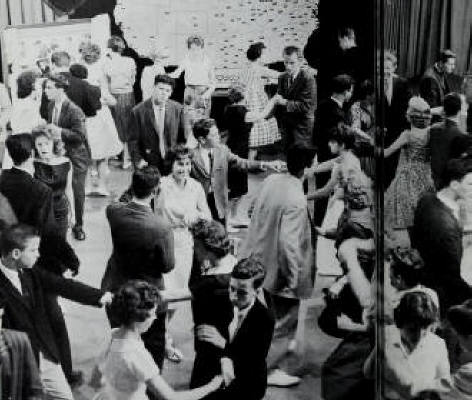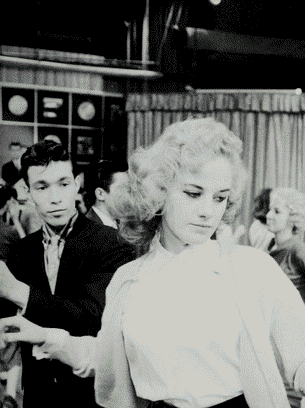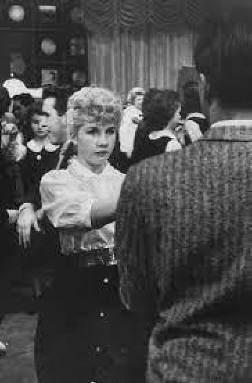|
|
|
|
|
|
|
|
|
|
|
After waiting outside on Market Street in the heat and cold and rain, kids lucky enough to get into American Bandstand were anxious and excited. Walking through the doors to Philadelphia's WFIL-TV's Studio B, where teenage life and music were all important, was like walking into Oz. The light, cameras, and music made the studio a magical place. There was, as with any television show, a lot of illusion. Television was still a relatively new medium in 1957, and studio was crude by today's standards. The cameras and lights were large, bulky, and hard to move, making trick shots of kids dancing virtually impossible. The studio was cold, the lights were hot, the music was loud, and the floor was hard. Girls wore sneakers or flat shoes to save their feet from soreness from the cement floor. But the kids were oblivious to the physical discomfort; they were the stars of the first TV show to feature real teenagers.
Carmella MonteCarlo and Charlie Zamal

American Bandstand was the first national TV show to
feature teens off the street. Carmella MonteCarlo and Charlie
Zamal were two high school students who danced on the show five
times a week. Bandstand dancers were local Philadelphia
kids fourteen to eighteen years old, mostly from two high
schools, West Catholic and South Philadelphia who came to dance
and to be seen dancing every afternoon from 2:30 to 5:00 P.M. It
was after-school fun, way for teenagers to express who they were
and, for a nationwide teen population with nine billion dollars
to spend in allowance money, Bandstand was the showcase
for latest records, the hippest fashions, and the newest products
The teens watching at home finally had a show that they felt part
of, learned from, and measured themselves against. Vera Badamo,
who grew up in Brooklyn Hills in the fifties, remembers how
"wonderful it was to come home everyday and tune in Bandstand
and see Italian kids, just like me. You never saw them on regular
TV. And, to see some of them wearing Catholic school uniforms was
extraordinary. I realized the kids in Philly were just like kids
in Brooklyn."
Lou DeSero a Bandstand Regular

Lou DeSero, a teen who appeared on American
Bandstand several times a week was loved for his
slicked-back, pumped up pompadour. In the late fifties,
Philadelphia boys were split on how to wear their hair. South
Philadelphians styled it high and shiny; North Philadelphians,
inspired by TV's Peter Gunn, wore their hair short and to the
side. For guys, tweed jackets, button-down shirts, and thin
patterned ties were the uniform.
Map of
Bandstand Afflilates

When American Bandstand went national on August 5, 1957
it had lined up affiliates on a small network of sixty-seven
stations. A map of the United States in the studio was dotted
with affiliate flags. By the end of the first year the show was
seen in 4,00,000 homes and local stations were clamoring to come
aboard. American Bandstand was much as a neighborhood
dance as it was a national television show. Dancing was an
integral part of the life in Philadelphia, the city that starts
the New Year dancing up Broad Street in the centuries-old
Mummers' Parade. The rest of the year there were dances
everywhere, from St. Alice's School where more than 2,000 teens
gathered on Friday and Sunday nights to the very small VFW dances
in Southwest Philadelphia where twenty people might show up.
Records

Dick Clark's world was records - playing them, producing them,
promoting them, and even pressing them. During the fifties, both
the 45 RPM and rock 'n' roll had a metric rise that would change
popular music forever. Until the, the recorded music was
primarily heard on heavy, awkward, and breakable 78 RPMs. The 45
made the 78 obsolete; it was light, small and practically
indestructible. And because it was cheaper to manufacture, it
gave independent record companies a fighting chance in the
industry. Rock 'n' roll was born with the 45 RPM. Teens could
easily carry the cheap, seven-inch disks to parties.
In 1957, 45s cost 69 cents in Philadelphia, and in many places.,
if you bought six, you got one free. Because Dick moved with the
times, by the end of the decade he owned or had interests in
thirty-three companies associated with the business.
Pat
Molittieri

Dancing in the 1950s was an extension of the pre-war dances,
couples touched; boys led and the girls followed. But within the
prescribed formats, individuality reigned, Pat Molitierri
demonstrates her expertise in Jitterbugging, the most popular
dance on the early Bandstand shows. Each dancer had his or her
particular style of Jitterbugging, but Pat's was the most unique
- she bounced. One of the most popular teens on the show, she had
her own advice columns in several teen magazines
Jitterbugging

When the kids on American Bandstand were not Strolling,
or Twisting, or Chalypsoing, they were usually Jitterbugging. The
Jitterbug was a Philadelphia staple, and there were many
variations as there were Philadelphia neighborhoods. The dance
began in the 1920s in the bars of Harlem and took the steps from
the Shag and the Charleston. Although dancers did wild
improvisational solos as part of the Jitterbug, it was
essentially a partner dance. In 1927, the solos gave rise to a
new variation, the Lindy Hop, named after Charles Lindbergh, who
had just made his historic solo flight across the Atlantic. The
Jitterbug gained wide popularity in the thirties when Swing was
at its peak. During WW II, U.S. soldiers took the dance around
the world and it was recognized as quintessentially American
Barbara
Marcen

Few things are as much fun for teenagers as dancing. It's a
chance to show off and be noticed. For the teens on American
Bandstand like Barbara Marcen, it was a chance to be seen by
millions The dancers, especially the regulars, were always
jostling for a spot in front. "we were brats about it,"
remembers Arlene Sullivan. We wanted to strut our stuff in front
of America," says Bunny Gibson. "But," says Carole
Scaldeferri, "Dick didn't want us hogging the camera."
"he used the studio mike to get us away from the front.
You'd be dancing, and all of a sudden you'd hear Dick's voice
telling you to drop back to the rear," says Kenny Rossi.
Myrna Horowitz says, "Dick wanted to give everyone a chance.
I didn't like dropping back, but I understood it."
Arlene Sullivan and Kenny Rossi

Arlene Sullivan and Kenny Rossi danced together n American
Bandstand for a little more than a year. At the height of
their popularity, they received as many as 500 letters a day.
Arelene, whose mother was a devoted fan, claims she danced on the
show "to get my mother's attention." Within three
months, Arlene was a regular appearing five days a week. "I
was always surprised," she says," that people wanted my
autograph. I danced on a TV show; nothing I did was
different than kids were doing in their basements. But maybe
that's why we were so popular. We were them, and they were
us."
Bandstand's Girl Next Door

Justine Carrelli was American Bandstand's girl next door Always
conservatively dressed and neatly coifed Justine was the girl
that every mother wanted to see her son marry. She first danced
on the show when she was only twelve, two years younger than the
rules allowed, thanks to her sister's birth certificate and
make-up. Justine was an instant hit; in a few weeks she was a
regular. When Justine met Bob Clayton and they started dancing
and dating her popularity soared - the two personified the
innocent lyrics of the songs they danced to.
Danny
and the Juniors

Danny and the Juniors, who appeared on the American Bandstand'
anniversary show in 1958, was a group of four teenaged boys whose
members went to John Bartram High School with some of the show's
regulars. Danny (Rapp) and the Juvenairs sang on the street
corners until Artie Singer of Singular Records heard on of their
songs "Do the Bop." He took them to Dick Clark who,
realizing the Bopwas on its way out as a dance craze, suggested
they change the lyrics. The song got a new title, "At the
Hop"(1957), which over night became a number on hit. The
group's "Rock and Roll Is Here To Stay" (1958) became a
teen anthem later that year
Jerry
Lee Lewis

The first Record played on the premiere network installment of American
Bandstand was Jerry Lee Lewis' call to action, "Whole
Lot of Shakin' Going On". His sharp clothes, animated
performances - Lewis was known for kicking the piano stool from
under him, playing the piano standing up, banging out chords,
rocking from side to side, and wildly tossing his hair -
electrified audiences. The success of "Great Balls of
Fire" sent the dapper singer's career into the stratosphere.
Searching For New Material

With thirty five records to play, the producers of American
Bandstand were constantly searching for new material. Clark
met in his office with representatives of the record industry to
keep apprised of the latest releases and the newest singers and
groups. But in 1959, following the scandalous revelations that
Charles Van Doren had been given answers while a contestant on
the popular TV quiz show Twenty-One (1956-1958) questions were
raised about the honesty of the record industry. Investigators
alleged that deejays accepted bribes to play certain songs,
otherwise there was no way to explain why many rock and roll
songs had become popular. Being the number one deejay in the
country, Clark was called to testify at the 1959-1960
Congressional hearings on payola. He swore he never took money or
gifts, but he was still forced to give up his interests in the
record business
Regulars Wating To Get On The Show

Janet Hamill (seated) waits with the rest of her friends to be
admitted to the WFIL studio.
Christmas |
Hong Kong |
New Year's Eve |
Ice Skating |
Roaring
Twenties |
Halloween |
Western |
|
|
|
|
|||
|
|
American
Bandstand broadcast special holiday shows for Halloween,
Christmas, and New Year's Eve. There were also theme shows
including a Skating Party, a Hong Kong Party, Roaring 20's Party
and a Western Party at Frontierland.
![]()